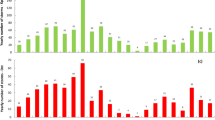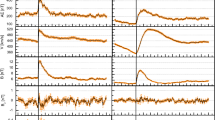Abstract
In this paper, we have examined the relationships between the characteristics of interplanetary coronal mass ejections (ICMEs) and geoeffectiveness in the declining phase of Solar Cycles 23 and 24. We discuss the results in comparison with those of the rising phase. Major results of this study are as follows: The ICMEs in the declining phase of Cycle 23 have generated higher storm strength than those in Cycle 24. The mean storm strength of the sheath and ICME for each cycle in the declining phase is greater than in the rising phase. This indicates that the declining phase is more geoeffective than the rising phase. Cycle 24 events seem to be slightly more geoeffective towards the second half of the cycle even though the cycle is weak in the rising phase. The mean radial size of ICMEs is \(\sim~0.36\) AU in Cycle 23 and \(\sim 0.32\) AU in Cycle 24. Around 25% of the ICMEs in Cycle 23 and 15% in Cycle 24 exceed \(\sim 0.5\) AU in size at 1 AU. The correlation between the southward magnetic component (\({B}_{s}\)) and the storm strength they cause is decisive in both cycles. This substantiates that the storm strength of the ICMEs strongly relies on the ICME \({B}_{s}\) in both cycles. The correlation between the storm strength/\({B}_{s}\) and the size of sheath/ICME seems insignificant, which suggests that the storm strength is independent of the size of the ICMEs. Almost 80% of geomagnetic storm peaks occurred in the ICME duration of the declining phase of Cycles 23 and 24, which is substantially identical to the rising phase. Summing up, this sort of study will be eminent to emphasize the variations in the rising and declining phases of solar cycles. The ICMEs are dominant in generating storms both in the rising and declining phases of a solar although in the declining phase they seem to generate more geoeffectiveness than in the rising phase.




Similar content being viewed by others
References
Bothmer, V., Schwenn, R.: 1995, J. Geomagn. Geoelectr.47, 1127. DOI .
Bothmer, V., Schwenn, R.: 1998, Ann. Geophys.16, 1. DOI .
Brueckner, G.E., Howard, R.A., Koomen, M.J., Korendyke, C.M., Michels, D.J., Moses, J.D., Socker, D.G., Dere, K.P., Lamy, P.L., Llebaria, A., Bout, M.V., Schwenn, R., Simnett, G.M., Bedford, D.K., Eyles, C.J.: 1995, Solar Phys.162, 357. DOI .
Cane, H.V., Richardson, I.G., St. Cyr, O.C.: 2000, Geophys. Res. Lett.27, 3591. DOI .
Dungey, J.W.: 1961, Phys. Rev. Lett.6, 47. DOI .
Echer, E., Gonzalez, W.D., Tsurutani, B.T., Gonzalez, A.L.C.: 2008, J. Geophys. Res.113, A05221. DOI .
Forsyth, R.J., Bothmer, V., Cid, C., Crooker, N.U., Horbury, T.S., Kecskemety, K., Klecker, B., Linker, J.A., Odstrcil, D., Reiner, M.J., Richardson, I.G., Rodriguez-Pacheco, J., Schmidt, J.M., Wimmer-Schweingruber, R.F.: 2006, Space Sci. Rev.123, 383. DOI .
Gonzalez, W.D., Gonzalez, A.L.C., Tsurutani, B.T.: 1990, Planet. Space Sci.38, 181. DOI .
Gonzalez, W.D., Tsurutani, B.T.: 1987, Planet. Space Sci.35, 1101. DOI .
Gonzalez, W.D., Joselyn, J.A., Kamide, Y., Kroehl, H.W., Rostoker, G., Tsurutani, B.T., Vasyliunas, V.M.: 1994, J. Geophys. Res.99(A4), 5771. DOI .
Gonzalez, W.D., Echer, E., Clúa de Gonzalez, A.L., Tsurutani, B.T., Lakhina, G.S.: 2011, J. Atmos. Solar-Terr. Phys.73, 1447. DOI .
Gopalswamy, N.: 2006, Space Sci. Rev.124, 145. DOI .
Gopalswamy, N.: 2008, J. Atmos. Solar-Terr. Phys.70, 2078. DOI .
Gopalswamy, N., Yashiro, S., Xie, H., Akiyama, S., Mäkelä, D.P.: 2015, J. Geophys. Res., Space.120, 9221. DOI .
Gosling, J.T.: 1993, J. Geophys. Res.98, 18937. DOI .
Gosling, J.T., Bame, S.J., McComas, D.J., Phillips, J.L.: 1990, Geophys. Res. Lett.17, 901. DOI .
Haigh, J.D., Winning, A.R., Toumi, R., Harder, J.W.: 2010, Nature467, 696. DOI .
Jang, M., Woods, T.N., Hong, S., Choe, G.S.: 2016, Astrophys. J.833, L11. DOI .
Kahler, S.W.: 1992, Annu. Rev. Astron. Astrophys.30, 113. DOI .
Kane, R.P.: 2009, Solar Phys.255, 163. DOI .
Lawrance, M.B., Shanmugaraju, A., Moon, Y.-J., Ibrahim, M.S., Umapathy, S.: 2016, Solar Phys.291, 1547. DOI .
Le, G., Cai, Z., Wang, H., Zhu, Y.: 2012, Astrophys. Space Sci.339, 151. DOI .
Leitner, M., Farrugia, C.J., Möstl, C., Ogilvie, K.W., Galvin, A.B., Schwenn, R., Biernat, H.K.: 2007, J. Geophys. Res.112, A06113. DOI .
Lindsay, G.M., Russel, C.T., Luhmann, J.G.: 1995, J. Geophys. Res.100, 16999. DOI .
Liu, Y., Richardson, J.D., Belcher, J.W.: 2005, Planet. Space Sci.53, 3. DOI .
Meng, X., Tsurutani, B.T., Mannucci, A.J.: 2019, J. Geophys. Res.124, 3926. DOI .
Mursula, K., Holappa, L., Lukianova, R.: 2017, Geophys. Res. Lett.44, 30. DOI .
Oh, S., Yi, Y.: 2017, Astrophys. J.840, 14. DOI .
Richardson, I.G., Cane, H.V.: 2010, Solar Phys.264, 189. DOI .
Schwenn, R., Dal Lago, A., Huttunen, E., Gonzalez, W.D.: 2005, Ann. Geophys.23, 1033. DOI .
Shen, C., Chi, Y., Wang, Y., Xu, M., Wang, S.: 2017, J. Geophys. Res., Space.122, 5931. DOI .
Tsurutani, B., Lakhina, G., Hajra, R.: 2019, Nonlinear Process. Geophys. Discuss.1, 100. DOI .
Wang, C., Du, D., Richardson, J.D.: 2005, J. Geophys. Res.110, A10107. DOI .
Wang, Y., Shen, C.L., Wang, S., Ye, P.Z.: 2003, Geophys. Res. Lett.30, 2039. DOI .
Webb, D.F.: 1995, Adv. Space Res.16(9), 57. DOI .
Xu, M., Shen, C., Wang, Y., Luo, B., Chi, Y.: 2019, Astrophys. J. Lett.884, L30. DOI .
Zhang, J., Richardson, I.G., Webb, D.F., Gopalswamy, N., Huttunen, E., Kasper, J.C., Nitta, N.V., Poomvises, W., Thompson, B.J., Wu, C.-C., Yashiro, S., Zhukov, A.N.: 2007, J. Geophys. Res.112, A10102. DOI .
Acknowledgements
M.-B. Lawrance thanks Y.-J. Moon and Kyung Hee University for supporting this work by an appointment through the Brain Korea 21 (BK21) plus Postdoctoral Program. This work was supported by the BK21 plus program through the National Research Foundation (NRF) funded by the Ministry of Education of Korea, the Basic Science Research Program through the NRF funded by the Ministry of Education (NRF-2013M1A3A3A02042232, NRF-2016R1A2B4013131, NRF-2019R1A2C1002634), the Korea Astronomy and Space Science Institute (KASI) under the R&D program “Study on the Determination of Coronal Physical Quantities using Solar Multi-wavelength Images (project No. 2019-1-850-02)” supervised by the Ministry of Science and ICT, and Institute for Information & Communications Technology Promotion (IITP) grant funded by the Korean government (MSIP) (2018-0-01422, Study on analysis and prediction technique of solar flares). We acknowledge the use of NASA/GSFC Space Physics Data Facility OMNI Web service, and OMNI data. The CME catalog we have used is generated and maintained by the Center for Solar Physics and Space Weather, The Catholic University of America in cooperation with Naval Research Laboratory and NASA. SOHO is a project of international cooperation between ESA and NASA.
Author information
Authors and Affiliations
Corresponding author
Ethics declarations
Disclosure of Potential Conflicts of Interest
The authors declare that they have no conflicts of interest.
Additional information
Publisher’s Note
Springer Nature remains neutral with regard to jurisdictional claims in published maps and institutional affiliations.
Rights and permissions
About this article
Cite this article
Lawrance, M.B., Moon, YJ. & Shanmugaraju, A. Relationships between Interplanetary Coronal Mass Ejection Characteristics and Geoeffectiveness in the Declining Phase of Solar Cycles 23 and 24. Sol Phys 295, 62 (2020). https://doi.org/10.1007/s11207-020-01623-1
Received:
Accepted:
Published:
DOI: https://doi.org/10.1007/s11207-020-01623-1




